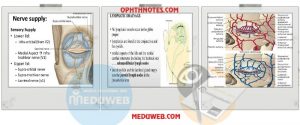Anatomy and physiology of the eyelids
Anatomy and physiology of the eyelids






• skin
• orbicularis oculi
• tarsal plates/septum
• conjunctiva






Skin and eyelashes in Anatomy and physiology of the eyelids



• arranged in 2–3 rows along the lid margins
• about 150 on the upper and 75 on the lower lid.
• replaced every 4–6 months
• grow back faster if cut.
• the lash follicles have apocrine sweat glands (of Moll) and modified sebaceous glands (of Zeis).
 Orbicularis oculi in Anatomy and physiology of the eyelids
Orbicularis oculi in Anatomy and physiology of the eyelids








 Orbital septum and tarsal plates in Anatomy and physiology of the eyelids
Orbital septum and tarsal plates in Anatomy and physiology of the eyelids




 Canthal tendons in Anatomy and physiology of the eyelids
Canthal tendons in Anatomy and physiology of the eyelids



 Fat pads in Anatomy and physiology of the eyelids
Fat pads in Anatomy and physiology of the eyelids

 Lid retractors in Anatomy and physiology of the eyelids
Lid retractors in Anatomy and physiology of the eyelids







• fascial extension from the terminal muscle fibers and tendon of the inferior rectus muscle, originating as the capsulopalpebral head.
• As it passes anteriorly from its origin, it splits to envelop the inferior oblique muscle and reunites as the inferior transverse ligament (Lockwood ligament).
• From there, the fascial tissue passes anterosuperiorly as the capsulopalpebral fascia.
• The bulk of the capsulopalpebral fascia inserts on the inferior border of the inferior tarsus.
• Fibers also pass forward, to the inferior fornix conjunctiva and through orbital fat to the orbital septum, and forward to the subcutaneous tissues forming the lower eyelid crease.
• The orbital septum fuses with the capsulopalpebral fascia approximately 5 mm below the inferior tarsal border.
• The inferior tarsal muscle (Müller muscle) lies just posterior to the fascia and is intimate with its structure.
• The sympathetically innervated smooth muscle fibers are first noted near the origin of the capsulopalpebral head.
• The capsulopalpebral head splits into 2 portions to pass around the inferior oblique muscle sheath; the portion beneath the muscle is thin and devoid of smooth muscle, while the portion above is a much thicker fascial layer and contains the smooth muscle fibers. As they continue to pass forward, the smooth muscle fibers do not insert directly onto the inferior tarsal border but into the fascia several millimeters below the tarsal border.
• In the Asian lower lid, the line of fusion of the orbital septum to the capsulopalpebral fascia is often higher, or indistinct, with anterior and superior orbital fat projection, and overriding of the preseptal orbicularis oculi over the pretarsal orbicularis.
• Lower Lid Retractors are of outmost important for lower lid surgeries or even surgeries on IO and IR muscles
 Conjunctiva in Anatomy and physiology of the eyelids
Conjunctiva in Anatomy and physiology of the eyelids



 Nerves in Anatomy and physiology of the eyelids
Nerves in Anatomy and physiology of the eyelids





 Arteries in Anatomy and physiology of the eyelids
Arteries in Anatomy and physiology of the eyelids



 Veins in Anatomy and physiology of the eyelids
Veins in Anatomy and physiology of the eyelids


 Lymphatics in Anatomy and physiology of the eyelids
Lymphatics in Anatomy and physiology of the eyelids



Anatomy and physiology of the eyelids powerpoint presentation :
Lecture outline Eyelid anatomy • Gross anatomy • Layers of the eyelid • Eyelid arterial supply and venus and lymphatic drainage • Eyelid nerve supply Eyelid physiology • Functions of eyelids • eyelid movements: Openning,clouser,bli nking and winking,bell’s -Dynamics of eyelid openning and clouser



 留言列表
留言列表


